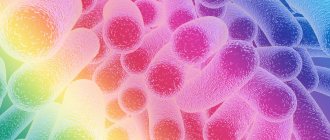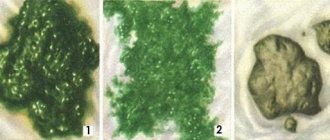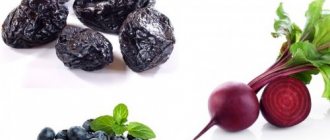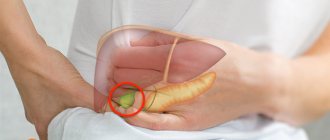Changes in the color of stool are a common reason for visiting a doctor. This symptom may be due to dietary habits and pathological conditions of the digestive system.
Thus, green stool in an adult often indicates an imbalance in the intestinal microflora. Additional examinations help identify other possible disorders and make a diagnosis.
Why is my stool usually brown?
Feces are a mixture of dead red blood cells, undigested food, bile, and waste products formed as food passes through the intestinal microflora. Dead red blood cells are black, bile is greenish-yellow, and waste from processing leftover undigested food by intestinal bacteria is brown. Therefore, the brown color of the stool is provided by intestinal bacteria, which also perform a number of other vital functions (for example, facilitating the absorption of nutrients from food entering the body).
Unhealthy stool color:
- Dark stools with mucus may indicate bleeding in the gastrointestinal tract
. The cause may be a burst stomach ulcer or other serious illnesses. - Yellow-green stools usually occur with diarrhea
. Yellow color may be associated with diseases of the liver and biliary tract.
Changes in stool color from dark brown to another shade (black, light or dark green) occur for a number of reasons, including bleeding from the rectum, stomach, or esophagus. Among the causes are diseases of the pancreas and gall bladder. But most often it is caused by diarrhea, in which food passes through the digestive tract faster than usual. Because of this, intestinal bacteria do not have time to give the stool the “correct” color.
Symptom of dysbacteriosis
Green stool is a symptom of dysbiosis
Dysbacteriosis is a pathology characterized by changes in the bacterial composition of the intestinal microflora.
This may be an increase in the number of microorganisms, the appearance of pathogenic bacteria, or the destruction of colonies. Dysbacteriosis negatively affects the functions of the digestive system and the psychological state of the patient.
Beneficial and neutral bacteria live in the large intestine. Microorganisms are usually presented in the form of colonies, protected from the penetration of other bacteria by resistance factors.
Bacterial cells help absorb vitamins and fiber, and also produce gaseous substances when digesting substrates. Excessive bacteria can cause increased gas formation, diarrhea and other unpleasant symptoms.
Causes of dysbacteriosis:
Is green poop a sign of cancer?
When green stool appears, there is no reason to immediately panic or create catastrophic scenarios. Although abnormally colored stool can be a sign of cancer, most cases involve black, sticky stool. This is due to either bleeding from the stomach, esophagus, duodenum, or impurities of fresh blood (for colorectal cancer).
Although green stool is not usually a symptom of cancer, it should not be underestimated, especially if other symptoms (severe diarrhea, abdominal cramps, vomiting, high fever) appear.
Green coloring of stool 1-2 times in a row without side effects, most often caused by artificial food dyes, consumption of some natural foods, in particular leafy vegetables and berries. A change in the color of feces in combination with periodic diarrhea, constipation, and vomiting may indicate nonspecific intestinal inflammation, such as Crohn's disease, irritable bowel syndrome.
Green color of baby's stool
An elevated temperature in a child leads to a change in the color of stool.
In the first month of life, green stool is quite normal for babies.
This occurs very often and is due to the baby’s adaptation to the environment and breastfeeding. However, the mother's panic may be justified if the following symptoms are present:
- Foul odor of fecal matter
- Heat
- Baby's refusal to eat
In this case, you should immediately contact your pediatrician, since the above symptoms indicate an infectious disease.
Food
The most common cause of green stool is a change in eating habits and consumption of certain foods. This condition is typical for infants and toddlers when consuming artificial milk (Nutrilon, Milupa, etc.) or other baby food. Until the digestive system is completely accustomed to the new food, their stool may be colored green. The condition returns to normal quickly (within a few days). If this does not happen, an examination is required.
Foods that cause green (usually dark or even black-green) stool include:
- spinach;
- broccoli;
- blueberry;
- cabbage.
Leafy vegetables contain chlorophyll, a green dye that allows plants to produce oxygen. But the human body is not able to digest chlorophyll, so after eating this vegetable, the stool turns green. But it doesn't do any harm. Leafy vegetables are good for health.
In addition to healthy foods, such as the above-mentioned types of vegetables and fruits, changes in the color of stool are also caused by artificial food colors added by manufacturers to certain foods. The human body cannot process them, so it excretes them unchanged.
Number of bowel movements
For an adult, normal stool is considered without prolonged strong straining once every 1-2 days or 2 times a day. After the process of defecation, there is a feeling of comfort and complete emptying of the intestines, and the urge completely disappears. Some external circumstances - bed rest, a change in familiar surroundings, the need to use a vessel, being in the company of strangers - can slow down or increase the frequency of this process.
A deviation from the norm is the absence of bowel movements for 3 days (constipation) or very frequent bowel movements - up to 5 times a day or more (diarrhea).
Up to contents
Bile dyes
Bile is a yellow-green liquid. It is formed in the liver, stored in the gallbladder, from where it flows through the bile duct into the small intestine. Along the way, it connects with the pancreatic duct, through which pancreatic juice enters the small intestine (duodenum). It contains pancreatic lipase, an enzyme that facilitates the absorption of fats. Bile activates pancreatic lipase, increasing its efficiency in digesting fats. As a result, more fat is absorbed from the small intestine into the body.
Bile dyes are a group of biological dyes; the most important is bilirubin. It is supplemented by biliverdin, which results from the breakdown of hemoglobin. Typically, bile decomposes as it passes through the intestines, its color changes to brown, and the remainder is excreted in the feces. But with diarrhea or other digestive disorders, the digestion of bile slows down, it is excreted unchanged, which can cause a change in the color of the stool from green to greenish-yellow.
Antibiotics and other drugs
Antibiotics, especially strong drugs used for severe infections, often destroy most of the health-promoting bacteria in the gut. Because bacteria produce brown waste in stool, a deficiency of bacteria results in green or greenish-black stool.
To prevent problems caused by antibiotics, it is recommended to take probiotics (a live culture that supplies the intestines with new bacteria) at the same time as they are taken.
There are other medications and nutritional supplements that cause changes in the color of stool. Among them are the following substances:
- Indomethacin. This drug belongs to the group of NSAIDs. It reduces inflammation and lowers temperature.
- Iron supplements. Basically, the reason for greenish stool is their use in large quantities. Sometimes constipation may also occur. After stopping the drug, the condition quickly normalizes.
- A number of hormonal contraceptives (in particular, those containing medroxyprogesterone).
Medical procedures such as bone marrow transplants can cause green stool. When the body rejects the transplanted bone marrow, severe gastrointestinal irritation, diarrhea, and green stools occur.
IMODIUM® Express in the fight against diarrhea
IMODIUM® Express is a drug that is approved for use in the symptomatic treatment of acute and chronic diarrhea of various origins. The active substance, loperamide, has the following effects:
- helps restore intestinal motor function - slows down the movement of feces and reduces the frequency of the urge to defecate;
- helps reduce the volume of water released into the intestinal lumen;
- helps regulate and restore the normal level of absorption of water and salts dissolved in it by the intestinal walls.
Before taking IMODIUM® Express, you should read the instructions and consult a specialist.
Gastrointestinal diseases
Some types of parasites, viruses, and bacteria can also cause changes in the color of feces. Most often these are intestinal lamblia (giardia lamblia), noroviruses. The presence of these microorganisms is accompanied by diarrhea with green stools. Sometimes this symptom also occurs with common traveler's diarrhea. As a rule, the condition returns to normal within a few days without the need for treatment. Greens in feces appear in Crohn's disease, ulcerative colitis, and other diseases of the digestive system accompanied by diarrhea (including hereditary disorders). Green stool in an adult can occur with irritable bowel syndrome, excessive use of laxatives (medicines that facilitate bowel movements).
An anal fissure is a tiny crack in the tissue around the anus, often caused by chronic constipation, the passage of hard stool. But sometimes this manifestation occurs with chronic diarrhea, nonspecific intestinal inflammation. Anal fissures can bleed, which causes the presence of blood in the stool and its coloration in a red-green hue.
Diagnostics
If green stool appears, you should consult a gastroenterologist. The diagnostic plan includes advanced laboratory tests and modern imaging methods of the digestive system. If necessary, the patient is referred for consultation to related specialists. The most informative ones are:
- Coprogram
. When examining green stool under a microscope, it contains a large number of undigested food particles, an increased content of red blood cells and white blood cells, which indicates inflammatory processes in the intestines. If intestinal bleeding is possible, the Gregersen occult blood reaction is performed. A fecal elastase test can rule out pancreatitis. - Bacteriological studies
. When the color of the stool changes, a microscopic analysis is always carried out for helminth eggs. Be sure to culture feces on selective nutrient media to detect typical intestinal pathogens: Salmonella, Escherichia, Shigella. If there are difficulties in diagnosis, blood ELISA is prescribed to detect antibodies. - Ultrasonography
. In an adult, the appearance of green stool is often caused by somatic reasons, for confirmation of which an ultrasound of the abdominal organs is required. Sonography allows us to exclude space-occupying lesions and other severe intestinal lesions. Targeted ultrasound of the liver and gallbladder is necessary to diagnose cholecystitis and hepatitis. - Radiography
. Double contrast irrigoscopy helps evaluate the structure of the colon and identify areas of mucosal destruction, deep ulcers or diverticula. Barium passage X-ray is an effective method with which you can assess the condition of all parts of the gastrointestinal tract and detect signs of peptic ulcer disease. - Additional methods.
FGDS is recommended for signs of gastroduodenal pathology. For patients with suspected inflammatory bowel disease, colonoscopy with biopsy sampling is indicated. To make a diagnosis of celiac disease, a cytomorphological examination of small intestinal biopsies is performed and specific antibodies are determined. To find out the cause of severe allergies, an immunogram is informative.
Nutrient malabsorption
This is a disorder associated with gastrointestinal diseases. Most nutrients are absorbed in the mucosa of the small intestine. This requires digestive enzymes from the pancreas and bile. Failure of any of these components results in a deficiency in the body's supply of nutrients.
| Disease | Characteristic |
| Celiac disease | An autoimmune disorder characterized by a cross-reaction of the body's antibodies against gluten |
| Lactose intolerance | A condition caused by a congenital or acquired deficiency of lactase, the enzyme that breaks down lactose |
| Short bowel syndrome | A condition in which the absorption area of the small intestine through which nutrients are absorbed is reduced. |
| Blind loop syndrome | A condition in which bacteria enter the small intestine, disrupting metabolism and the normal functioning of bile |
| Irradiation of the small intestine | A disorder that occurs when malignant neoplasms in the abdominal cavity are irradiated |
| Intestinal amyloidosis | A systemic disorder in which the compound amyloid accumulates in an organ |
Treatment involves a combination of cause-and-effect solutions. The patient’s diet is adjusted, missing nutrients, minerals, and vitamins are introduced. If necessary, drug treatment is prescribed.
Consistency (density) of stool
Normally, the stool is soft and formed. Feces should consist of 70% water, 30% from the remains of processed food, exfoliated intestinal cells and dead bacteria.
The presence of pathology is indicated by liquid, foamy, ointment-like, mushy, semi-liquid, excessively dense or putty-like stool.
- Pasty stools – with increased peristalsis, inflammation or increased secretion in the intestines, may be associated with the consumption of large amounts of plant foods.
- Very dense “sheep” feces - observed with constipation and dehydration, may be a sign of a mechanical obstruction in the rectum.
- Ointment-like - observed in diseases of the pancreas, a sharp decrease in the flow of bile into the intestines, and may be associated with increased consumption of fatty foods the day before. The frequent appearance of ointment-like stool may be a symptom of pancreatic diseases and insufficient bile secretion.
- Liquid - observed when the passage of feces is accelerated, the absorption or digestion of food in the small intestine is impaired, it is a symptom of toxic infection, acute intestinal infection, poisoning.
- Foamy - observed when fermentation processes in the intestines prevail over the rest.
Up to contents
Salmonellosis
This is an intestinal infectious disease, usually not fatal, but unpleasant. It is risky for both children and adults. Its causative agent is the bacterium Salmonella enteritidis. This pathogen belongs to the group of Salmonella, which causes a number of other diseases (in particular, typhoid fever). The bacterium is often found in milk, eggs (and all products containing eggs, especially egg mayonnaise).
Sufficient heat treatment of any of the risky products destroys salmonella.
When food containing Salmonella bacteria is consumed, pathogens enter the intestines, attack the cells of the intestinal wall, and inflammation occurs. The infection manifests itself as fever, diarrhea with loose, watery stools. It is usually green in color and may contain mucus and blood. Abdominal pain, nausea, and vomiting may occur. In people with weakened immune systems (eg, people with AIDS), salmonella can enter the bloodstream and spread throughout the body. In this case, serious blood poisoning (sepsis) occurs, which can be fatal. The main prevention of the disease is to avoid eating foods (especially dairy and eggs) from unknown sources, especially in the absence of proper heat treatment of food.
Treatment measures at home
Treatment of diseases is carried out in the infectious diseases department or gastroenterology, depending on the diagnostic results. If salmonellosis is suspected, pre-medical care includes:
- plenty of drinking regimen, even when vomiting you should give boiled warm water to drink in small portions, the best drug is Regidron;
- taking sorbents - drugs that attract toxins in the intestines and remove them with feces; activated carbon (every 2 hours an adult should drink 4 tablets), Smecta, Polysorb are suitable.
Do not rinse the stomach, give antibiotics or drugs that stop intestinal motility. Toxic substances should be removed with diarrhea. If bleeding is suspected, the patient should be placed on his side, prohibited from getting up, a heating pad with ice or cold water should be placed on his stomach (something from the freezer, wrapped in cellophane and a towel will do), you can allow him to swallow small pieces of ice.
When to seek medical help?
You should consult a doctor if symptoms, in particular diarrhea, persist for more than 3 days. Prolonged diarrhea can lead to dehydration and malabsorption. A visit to a specialist is also required if green stool is accompanied by other symptoms, such as abdominal cramps, blood in the stool, and nausea.
It is often uncomfortable for a person to talk to a doctor about stool and its external characteristics, but it is necessary. The doctor is called to help improve the condition. Before visiting, it is advisable to make a list of medications you are taking. It is also important to inform your doctor about your eating habits (if there are no changes, about recently consumed foods) and the presence of other diseases. This is the only way to make a correct diagnosis, determine the cause of green stool, and apply the correct treatment.
With a one-time symptom, as a rule, we are not talking about a serious problem. It is most likely caused by eating leafy vegetables. If the green tint of stool persists for more than 3 days in a row, accompanied by other signs mentioned above, a disorder may occur that requires a specialized therapeutic approach.
You should quickly consult a doctor if there is bright red blood in the stool, or if it turns black (this may be a sign of melena - the presence of digested blood in the stool). But sometimes blueberries and licorice consumed the day before can cause it to turn black.
Treatment
Help before diagnosis
Greenish color of stool associated with the consumption of certain foods does not require specific therapy. It is enough to exclude provoking factors from your diet, and after a couple of days the color of the stool will normalize. If the symptom is accompanied by nausea, diarrhea, or abdominal pain, you should consult a doctor to find out why the stool has turned green. The presence of blood streaks in the stool is an indication for emergency hospitalization.
Conservative therapy
An important component of treatment is a special diet. In the acute period of intestinal infections and other gastrointestinal pathologies, a person is transferred to a gentle diet - mucous soups, pureed porridge with water. After normalization of stool, the patient gradually returns to his usual diet. Celiac disease is treated with a lifelong gluten-free diet. Medications are selected depending on the cause of green stool. For therapeutic purposes use:
- Sorbents
. Prescribed for all cases of greenish stool and diarrhea, as they effectively remove toxic metabolic products and bacterial agents from the body. Darkening of stool due to the use of activated carbon preparations is a normal variant. - Probiotics
. In case of dysbiosis, during the recovery period after intestinal infections, probiotic agents are necessary for the colonization of the colon with beneficial lactobacilli. The drugs improve motility, eliminate abdominal discomfort, and help normalize the frequency and consistency of stool. - Antisecretory agents
. In hyperacid conditions, medications that reduce acidity in the stomach and prevent the development of ulcers and bleeding from the gastrointestinal tract are effective. Preference is given to protein pump inhibitors, which have a long-lasting effect and minimal side effects. - Enzymes
. For the gastrointestinal form of intestinal infections and chronic enteritis, pancreatin and dry bile have a good therapeutic effect. Enzyme replacement therapy stimulates digestion and eliminates malabsorption syndrome, due to which all dyspeptic disorders disappear. - Antibiotics
. Antimicrobial agents are indicated for severe generalized forms of bacterial diseases to target the infectious causes of the disorder. Mostly medications from the group of fluoroquinolones and tetracyclines are used. Sometimes therapy is supplemented with sulfonamides. For viral infections, etiotropic drugs are not prescribed.
Treatment of causes of changes in stool color
If a person has an allergy, intolerance, or sensitivity to certain foods that cause chronic diarrhea, the risky food should be eliminated from the diet or its consumption reduced. This is mainly caffeine, dairy, fatty products, carbonated drinks. Keep a diary and write down which foods cause problems.
Treatment of a patient with infectious diseases is carried out by doctors from the infectious diseases department.
In case of infection, bed rest and increased fluid intake are usually prescribed (to prevent dehydration). It is advisable to use drugs that cleanse the intestines (for example, drugs containing dichloroquinoline). In severe cases, antibiotics are also prescribed.
In most cases, green stool is a condition that does not require concern. Long-term persistence of the problem may indicate the presence of a serious illness, but a one-time case may indicate the presence of natural dyes (from spinach, broccoli) in the stool.
Treatment for green stool caused by salmonella
Treatment of salmonella depends on the clinical form of the disease and the patient’s immune status. Therapy is symptomatic. The most important thing is to replenish fluids and minerals.
Treatment consists of:
- rehydration (oral and parenteral);
- diets;
- drug therapy;
- Antibiotics (penicillin, cotrimoxazole, quinolones).
In all acute diarrheal illnesses, rehydration is critical. It should take into account the basic daily fluid requirement, stool volume, vomiting, and temperature.
For salmonellosis, it is important to exclude all fatty, irritating foods, milk, meat, including diet ham, chocolate, leafy vegetables, fresh fruits (except bananas, grated apples). The diet includes mashed potatoes, rice, root vegetable soup, dry bread. Gradually, as the condition improves, pasta, lean meat, and fruits are added.
Medicines used include intestinal disinfectants and adsorbents. Drugs that slow down intestinal motility are not suitable for salmonellosis, because they enhance the absorption of toxic bacterial products.
Treatment of green stool caused by malabsorption
Symptoms should disappear once the offending foods are eliminated. If you are lactose intolerant, avoid milk and some dairy products. You can try lactase tablets, lactase-containing milk, or milk without milk sugar.
If you have celiac disease, you must follow a gluten-free diet that excludes products from wheat, rice, oats, and other grains. Gluten is also found in a number of processed foods, so it's a good idea to carefully research what ingredients are in each product.
Patients with malabsorption are prescribed high doses of vitamins and minerals. In case of lactose intolerance, calcium intake is increased (the daily dose of the supplement is 500 mg 2-3 times a day). Tablets containing live Lactobacillus bacteria may reduce flatulence, diarrhea and other symptoms associated with taking antibiotics, such as green stool. Lactobasillus acidophilus restores the natural intestinal microflora disturbed by drug therapy and diarrhea.
Treatment of green stool caused by parasitic infections
Parasites sometimes disappear on their own. But specialized treatment is always advisable, especially if symptoms are long-lasting.
Each disease has a specific treatment. Sometimes it is necessary to use antibiotics, sometimes corticoids, drugs that act directly against parasites. The choice of method always depends on the severity of the condition.
In most cases, the body copes with viral diseases on its own. Regular replenishment of fluids and proper nutrition are sufficient. The body needs to replenish missing minerals lost during diarrhea and vomiting. During treatment, auxiliary drugs in the form of probiotics and minerals can be used to support the exhausted body and stabilize the intestinal microflora.
Mild forms of bacterial infections are treated with sufficient fluids and a strict diet. Activated carbon and other anti-diarrhea medications are used. Imodium and Hilak forte are prescribed. For localized inflammation, antibiotics are used. In severe cases, hospitalization is required.
Treatment for green stool caused by anal fissure
An anal fissure either heals on its own or usually becomes chronic after 3 days. Treatment can be conservative or surgical. Conservative therapy includes sitz baths (in a decoction of chamomile, oak bark), laxatives, suppositories with a substance that affects the tension of the anal sphincter (antispasmodics), and analgesics.
The goal of surgical treatment is to heal the crack itself in the wall of the rectum and influence the tension of the anal sphincters. Dilatation (enlargement) of the rectum is performed under local or short general anesthesia. The expansion provides blood circulation to the torn edges of the crack, improving healing.
The crack is also removed (excision). This is a less effective method and does not affect sphincter tension. The first choice method is the Eisenhammer operation or internal lateral partial sphincterotomy (intersection of 1/3 of the height of the internal sphincter). This is a delicate surgical procedure that can lead to fecal incontinence and should be performed by an experienced proctologist.
Causes during pregnancy
Digestion in a pregnant woman is no different from the physiological processes of a healthy person. It is possible that sensitivity to certain foods increases due to a change in taste. Therefore, the basis for green stool during pregnancy should be sought in nutrition. Pregnant women enjoy eating: broccoli, dill, spinach, parsley. An increase in the rate of transit of such plant products through the intestines has an effect.
Some vitamin supplements containing iron also affect stool color. They are prescribed by obstetricians quite often to prevent anemia. Managing pregnancy in women with chronic diseases requires the attention of a doctor and relatives. It is impossible to predict an exacerbation in advance. Therefore, it is necessary to come early for examination if you have suspicious bowel movements.
The ban on spicy foods and pickles increases the need for fresh greens
Risks of changes in stool color
Removing waste is one of the main, most important functions of the human body. The appearance and smell of the stool itself indicates the state of health and warns of a serious illness. Therefore, paying attention to its changes is advisable.
Greenish stool with mucus is most often caused by nonspecific inflammation of the intestinal mucosa. The condition itself is not dangerous; the problem arises when it occurs simultaneously with rectal bleeding, because Irritable bowel syndrome may occur.
Hard, heavy stools are a common consequence of insufficient fluid and fiber intake. Such stools may be dark in color, mainly due to prolonged residence in the colon.
Constipation and diarrhea indicate an intestinal imbalance that can weaken the immune system. Prolonged diarrhea may indicate serious intestinal illness; there is a risk of dehydration. Long-term constipation can cause eczema, hemorrhoids, and psychological discomfort.










